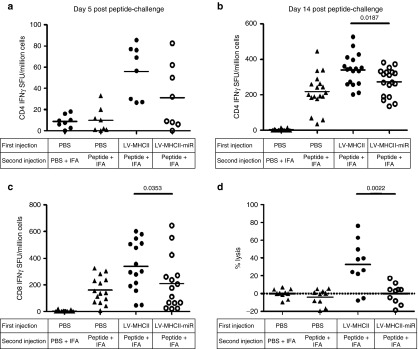Figure 5.
Immunization with LV-MHCII-miR does not lead to memory T cell responses. C57Bl/6 female mice were injected IV with PBS, LV-MHCII or LV-MHCII-miR. After 35 days, mice were challenged by an IM injection of a mixture of Dby and Uty peptides complexed with IFA or as control with PBS complexed with IFA. IFN-γ secretion of splenocytes was assayed. (a) Five days after the challenge following a 24 hours Dby restimulation. (b) Fourteen days after the challenge following a 24 hours Dby restimulation or (c) Uty restimulation. Each symbol represents IFN-γ spot-forming unit (duplicate measures) of each mouse from 2 to 3 independent experiments (n = 8– 18 mice per group) (d) C57Bl/6 female mice were injected IV with PBS, LV-MHCII or LV-MHCII-miR. After 35 days, mice were challenged by an IM injection of a mixture of Dby and Uty peptides complexed with IFA or as control with PBS complexed with IFA. After 13 days, a mix of congenic C57Bl/6 CD45.1 male CFSElow labeled cells and female CFSEhigh labeled cells were injected in mice (107 cells per mice). After 42 hours, spleen cells were harvested and the CFSElow C57Bl/6 CD45.1 male cells lysis was assessed by flow cytometry and normalized with the CFSEhigh C57Bl/6 CD45.1 female cells (n = 2, 10 mice per group).CFSE, carboxyfluorescein succinimidyl ester dye; IFA, incomplete Freund adjuvant; IFN, interferon; IV, intravenously; IM, intramuscularly; LV, lentiviral vectors; PBS, phosphate buffered saline.

